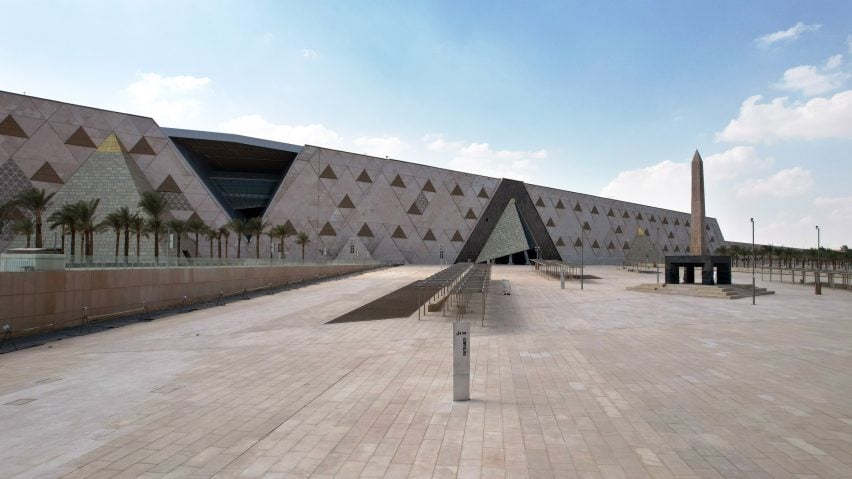The long-awaited Grand Egyptian Museum by Dublin studio Heneghan Peng Architects has been captured ahead of its scheduled opening in Giza, Egypt, later this year.
In the photos shared by the International Finance Corporation (IFC), the colossal building, also known as the Giza Museum, is framed against the Pyramids of Giza.
Heneghan Peng Architects' design for the museum encompasses 90,000 square metres of a 50-hectare site, making it the world's biggest museum.
It is being built for the Egyptian Ministry of Culture to house more than 100,000 pharaonic artefacts from Ancient Egypt and, alongside exhibition space, there will be a children's museum, conference centre, auditorium, conservation spaces and gardens.
Plans for long-awaited museum began in 1992
Plans for the Grand Egyptian Museum were first revealed in 1992 when former president Hosni Mubarak set aside a site approximately two kilometres from the three Giza pyramids for the project.
It wasn't until 2012 that construction began, nine years after Dublin studio Heneghan Peng Architects won an international competition to design the building with engineering by UK firms Arup and Buro Happold.
The studio completed the concrete shell of the Grand Egyptian Museum in 2015 and, at the time, opening was projected for 2018. However, a number of political and economic setbacks mean the museum remains unopen.
The current estimated opening is late spring 2024, according to a third-party site documenting the museum's progress.
The photos have been released by IFC, a private sector branch of the World Bank, following the building's receipt of IFC EDGE Advanced Green Building Certification.
It is the first museum in Africa to receive certification from the award programme, which celebrates buildings designed to ensure resource efficiency.
According to IFC, the Grand Egyptian Museum received it for its "resource-efficient and climate-smart design and construction".
"The project was designed to meet green building specifications, resulting in over 60 per cent energy cost savings and 34 per cent water use reduction compared to a conventional building of the same size and type," said IFC.
"The museum, which has a site area of half a million square meters, has taken sustainability measures including a reflective roof, external shading for thermal comfort, resource-efficient lighting, and water fixtures, in addition to the use of smart meters for energy consumption."
Museum will contain over 100,000 antiquities
In the photos, the wedge-shaped structure and limestone cladding of the Grand Egyptian Museum is visible. Triangular openings and wall panels can also be seen – a motif expected to feature throughout the building.
Once complete, the museum's vast collection of pharaonic artefacts from Ancient Egypt will include antiquitie from the tomb of King Tutankhamun, displayed in full for the first time since they were discovered in 1922.
A ritual vessel or "solar barge" called the Khufu ship, which was buried next to the Great Pyramid in 2,500 BC, will also be on show.
Many artefacts will be displayed across the 4,000 square metres of permanent exhibition space, which Heneghan Peng Architects said equates to "almost four football fields in size".
A notable feature of the project includes a colossal entrance atrium with a grand staircase and a 3,200-year-old sculpture of Egyptian pharaoh Rameses II.
Visual connections to the Pyramids of Giza will be prioritised throughout, while a two-kilometre-long and 500-metre-wide passage will lead directly to the complex.
Once complete, the museum will take the title of the world's largest museum from The Louvre in Paris, France, which encompasses 73,000 square metres.
Another giant museum recently featured on Dezeen is the Zaishui Art Museum, a one-kilometre-long building that Japanese architect Junya Ishigami created over a lake in China.

